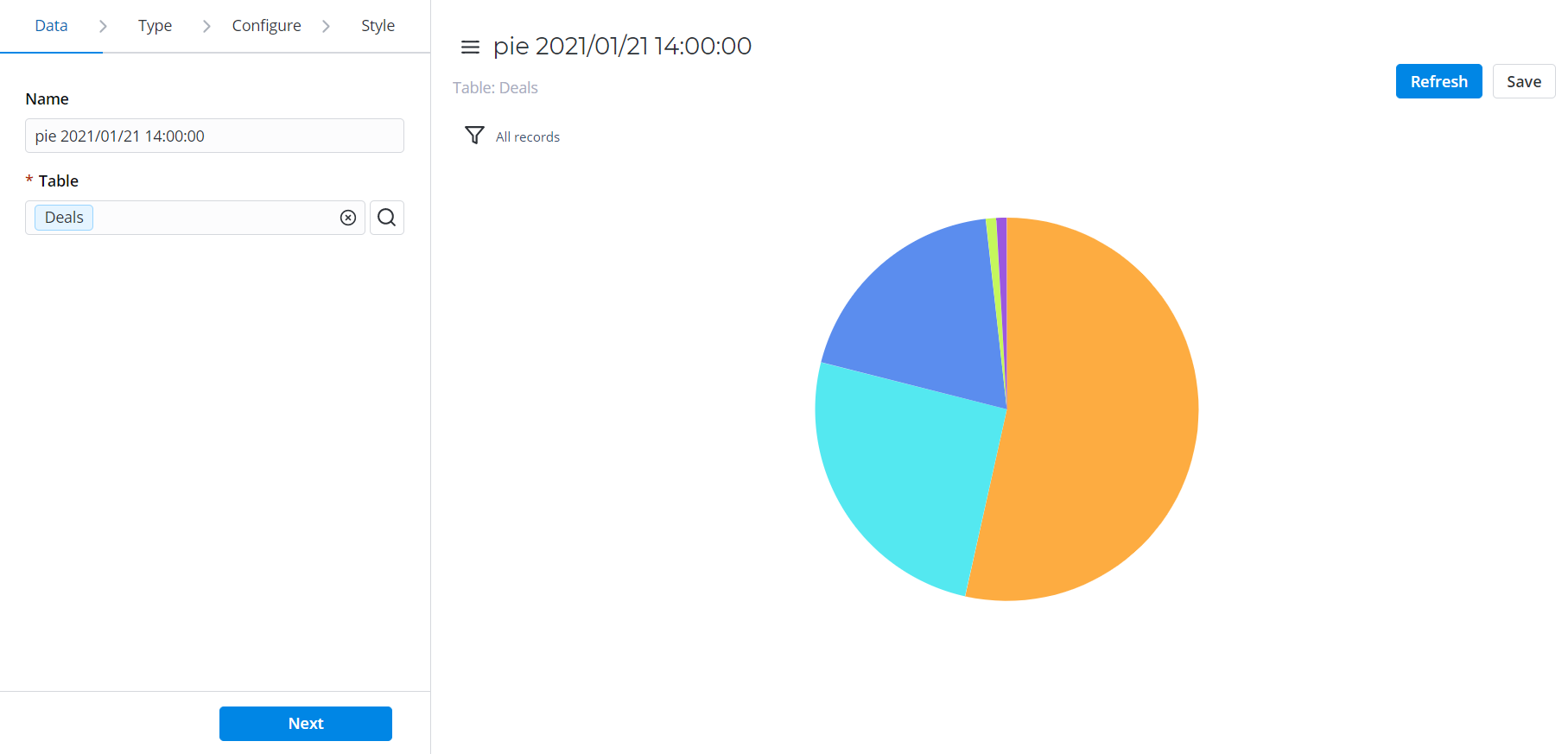Versions Compared
Key
- This line was added.
- This line was removed.
- Formatting was changed.
SimpleOne allows creating you to create reports using the Report Designer and or directly from the a table containing data table.
| Note |
|---|
The Report Designer can stop the report generating if the data amount If the amount of data is too large to display. Use the Condition Builder to limit the , this may prevent the Report Designer from generating reports. Use the condition builder to limit data sampling or try another type of report. |
Create
report from list layoutYou can createa report
via list layout directly from the list view using a table column as the grouping criteria.| Info |
|---|
Pie and Bar charts are only available for this way of report creating. |
To create a report from a table, follow the steps below:
with the Report Designer
 Image Removed
Image Removed Image Removed
Image Removed
The process of report generation with the Report Designer is conveniently divided into four steps.
- Navigate to the Reports → Create New menu.
- Set Data– set up the data source with one of the data tables.
- Select the typeType– select a type of report you want to create.
- Configure the data.– establish the dataset and criteria for analyzing it.
- Style – customize the report look and feel using the style settingsCustomize the style.
- Click Save to apply the changes.
| Info |
|---|
To navigate through the Report Designer, use the Back and Next buttons or click on the tabs after select the subsequent tab after filling in the mandatory fields on the previous tab. |
| Anchor | ||||
|---|---|---|---|---|
|
Data
| Panel | ||
|---|---|---|
| ||
|
| Anchor | ||||
|---|---|---|---|---|
|
Type
| Panel | ||
|---|---|---|
| ||
|
| Note |
|---|
Please note Note that changing existing the selected report type is not allowed after the report is created. You can create new record with a copy of the record using similar data but of selecting another report type instead. For thisTo do so, please complete the steps below:
|
| Anchor | ||||
|---|---|---|---|---|
|
| Panel | ||||||||||||
|---|---|---|---|---|---|---|---|---|---|---|---|---|
| ||||||||||||
|
| Anchor | ||||
|---|---|---|---|---|
|
Style
| Panel | ||||
|---|---|---|---|---|
|
Create a report from a
Bar Reporttable
You can create a report via a list layout directly from a table, using a table column as the grouping criteria.
| Info |
|---|
Pie and Bar charts are available only for this way of report creation. |
To create a report from a table, follow the steps below:
- Navigate to the table to create a report from.
- Click the table column that you want to group the data by.
- Select one of the context options:
- In the Report Designer, customize your report data and its style using the tabs.
- Click Refresh to see the changes.
- Click Save to apply the changes.
 Image Added
Image Added
Bar Reports display categorized data in vertical bars which length is proportional to the data values. Stack or group bars to make the chart representation visual and clear.
This report view is useful for dividing data into categories and comparing them.
Create a Pie Report
Pie Reports display data in a circular graphic divided into slices. The whole graph represents the entire report data with each slice proportionally displaying a particular data category.
This report view is useful to compare the proportions of individual values to the whole.
Create a Gauge Report
Gauge Reports represent a single metric value from the data via the gauge panel with a dial on it.
This report view is useful for evaluating the criticality according to the established limits set.
Create a Digit Report
Digit Reports provide a simple digit representation of a single metric value.
This report view is useful for monitoring the critical parameters by clear visual presentation.
Create a Line Report
Line Reports represent data as a graph of points connected by a line and visualize the metric data values.
This report view is useful for comparing data per time periods (years, months, etc.).
Create a Pivot Table Report
Pivot Reports represent your data in a table view with aggregating, grouping, and analyzing using two metrics as row and column for your chart.
This report view is useful for issues of comparing, summarizing, and counting a large amount of data.
Create a Multilevel Pivot Table Report
Pivot Tables Reports represent your data in a table view. The data is aggregated, grouped, and analyzed basing on two metrics (as row and column).
This report view is extremely useful for issues of comparing, summarizing, and counting a large amount of data.
Create a List Report
List Reports represent table data in a list view.
Create a Heatmap Report
Heatmap Reports display your data as the intersection of two metrics in a table with colored cells. These cells contain data values visualized with color brightness.
Create a Trend Report
Trend reports show the dynamics of data changes. The data is represented as columns over periods.
This report type is useful for monitoring time parameters.
| Table of Contents | ||||
|---|---|---|---|---|
|
...






